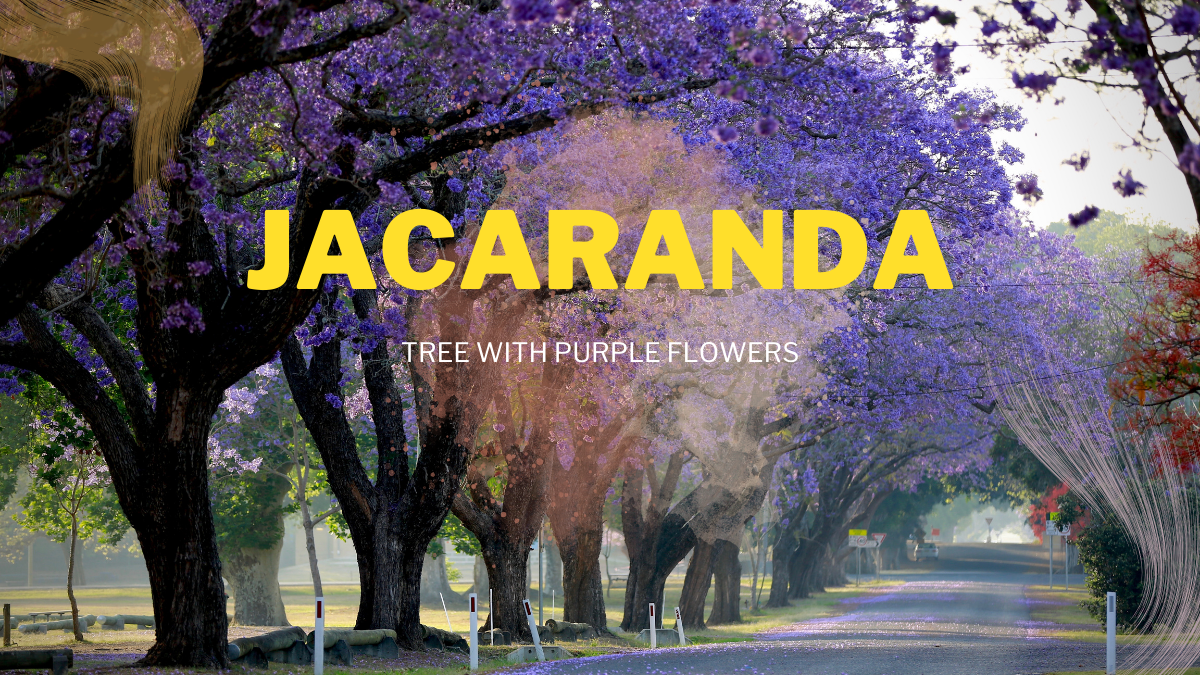To all those who like spending time in the wonderful outdoors! Are you someone who has ever been captivated by the ethereal tree with purple flowers that adorn the boulevards and green areas of the United States? Oh, yeah! It is none other than the magnificent jacaranda tree, which is stealing the show and enthralling those individuals who are seeing it. The wonderful appeal that these floral wonders give to our horizons is something that we should investigate, so let’s start our journey.
Delving into the Enigmatic Origins of Jacaranda Tree with Purple Flowers
So, whence do these botanical divas originate? Hailing predominantly from the verdant landscapes of South America, particularly Argentina, and Brazil, jacaranda trees have enraptured admirers for eons with their resplendent, purple blossoms. They made a splashy debut on American shores in the waning years of the 19th century, and oh, how they’ve continued to mesmerize! Unearth their historical tapestry, and you’ll stumble upon the profound cultural resonance these arboreal wonders possess and the transformative influence they’ve exerted upon the American tableau.
The Multifaceted Benefits of Planting Jacaranda in the U.S.
Ah, jacarandas! They’re not merely a feast for the eyes. These arboreal champions are akin to the superheroes of the botanical realm, bestowing a plethora of benefits.
Ecological Sustainability:
Jacarandas are essential for local ecosystems and sustainability. Bees, butterflies, and birds flock to the tree with purple flowers for honey and pollen. Jarandas improve ecosystem health and resilience by promoting local biodiversity.
Drought Resistance:
Jacaranda trees are known for their drought resistance. They thrive in water-scarce locations and places with little irrigation. Their drought tolerance makes them a sustainable landscaping option since they save water and need less irrigation.
Energy Saving:
The canopy of jacaranda trees provides shade, particularly during hot summer months. This natural shadowing may dramatically decrease the temperature surrounding buildings and paved areas, decreasing air conditioning use and energy usage. Thus, jacarandas reduce the urban heat island effect and promote energy efficiency.
Aesthetic appearance:
Jacarandas are known for their aesthetic appeal, in addition to their ecological advantages. This tree with purple flowers transforms urban settings into magical displays of color and beauty. Jacarandas provide elegance and liveliness to city streets, parks, and private gardens.
Cultural value:
Many areas grow jacaranda trees for their cultural value. The late 19th-century immigrants brought a rich tapestry of South American cultures, experiences, and memories to the U.S. Thus, planting jacarandas may celebrate ethnic variety and tradition, improving communities.
Navigating the Jacaranda Landscape in the U.S.
You might surmise that locating these botanical gems poses a challenge given their non-native status, but lo and behold! They flourish in several states graced by favorable climates. California steals the limelight, with jacarandas adorning the avenues of Los Angeles and San Diego, their purple petals a sight to behold. Yet their charm extends further; you’ll find them lending vibrant hues to Miami, Tampa, and even pockets of Texas, Arizona, and Hawaii. So, keep your senses alert for these mesmerizing trees, whether meandering through metropolitan byways or traversing scenic highways.
Essential Landscaping Guidelines for Cultivating Jacaranda Trees
Adding a jacaranda tree to your garden or landscape may be gratifying, but it needs careful planning and care to thrive. Consider these gardening tips:
Soil and Sunlight Requirements:
Jacaranda trees grow in well-drained, slightly acidic to neutral soil. The soil health, pH, and drainage must be tested before planting. If needed, add compost or old manure to increase soil texture and fertility. Jacarandas also need plenty of sunshine. Choose a planting spot for a flowering tree with purple flowers with 6–8 hours of full sun for strong growth and abundant blooming.
Regular watering:
It is necessary for jacaranda trees, even though they are drought-resistant once established, particularly during their early development and hot, dry months. Deep, infrequent watering promotes a strong root system. Reduce watering to prevent root rot and other fungal infections.
Pruning and Maintenance:
Jacaranda tree care requires pruning to preserve its beautiful shape, remove dead or damaged branches, and promote healthy growth and blooming. Before new growth develops, prune your jacaranda tree in late winter or early spring. Cut cleanly at 45 degrees with sharp, clean pruning shears. To maintain your jacaranda tree healthy and bright, remove fallen leaves and debris from the base and check for pests and illnesses.
Companion plants:
Consider companion planting for a harmonious and attractive environment surrounding your jacaranda tree. Select plants and trees with purple flowers that match their attractiveness and flourish in comparable soil and sunshine. Lantana and periwinkle groundcovers provide a colorful carpet under the tree, while rosemary and lavender plants give texture and smell.
Fertilizer:
Regular fertilizer helps preserve Jacaranda trees’ health and encourages lush foliage and bright blooms. Follow the manufacturer’s recommendations to apply a balanced, slow-release tree and shrub fertilizer in early spring. Overusing nitrogen fertilizers might reduce blooming and increase luxuriant growth.
Frost and Cold Shelter:
Jacaranda trees are cold-hardy, although young or recently planted individuals may need shelter from freezing conditions. Wrap the tree in frost cloth or burlap during cold spells and mulch the base to insulate the roots.
These fundamental landscaping principles can help your jacaranda tree develop and convert your outside area into a beautiful and peaceful oasis. To grow a healthy and bright jacaranda in your environment, pay attention to each tree’s specific needs.
A Primer on Caring for Your Jacaranda Trees with Purple Flowers
Sustaining the splendor of your jacaranda trees with purple flowers demands consistent care. Arrange routine inspections to nip potential ailments or pest infestations in the bud. Trim away any withered or damaged branches to invigorate healthy proliferation. Maintain their hydration levels, especially during parched periods, and fortify them with spring fertilizers to stimulate lush foliage and vibrant blossoms. Should you require professional guidance, arborists are at your service. By dedicating yourself to their care, you’ll relish the resplendent beauty of jacaranda trees throughout the seasons.
In Summation: Jacarandas – Nature’s Living Canvases
In a nutshell, a jacaranda tree with purple flowers is more than just trees that grow in trees; they are living tapestries that enrich every area that it beautifies. Urban landscapes have been transformed into mesmerizing visual symphonies as a result of their spectacular greenery and vibrant purple blooms. Embrace the fascination of jacarandas, allow them to ignite your imagination, and make a commitment to their maintenance so that they may permeate your surroundings with a kaleidoscope of colors. When you have greater respect for nature, you will be able to comprehend the majesty of jacaranda trees and the entrancing aura that they provide to our planet.
FAQs
Q: What is the name of the tree with purple flowers?
A: The tree that flaunts purple blooms is known as the Jacaranda tree.
Q: What invasive tree has purple flowers?
A: An example of an invasive tree with purple flowers is the Princess Tree or Paulownia tomentosa. While it boasts gorgeous purple blossoms, it can become invasive in certain areas.
Q: Which plant has purple flowers?
A: Numerous plants boast purple flowers, with some popular choices being lavender, petunias, and lilacs.
Q: What are the benefits of the jacaranda tree?
A: The Jacaranda tree comes with several perks. It offers shade, helps purify the air by absorbing carbon dioxide, lures pollinators such as bees and butterflies, and aids in preventing soil erosion due to its extensive root system. Additionally, its breathtaking purple flowers enhance the aesthetic appeal of landscapes.





